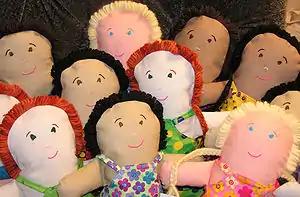Rag doll
A rag doll is a children's toy. It is a cloth figure, a doll traditionally home-made from (and stuffed with) spare scraps of material. They are one of the oldest children's toys in existence. Today, many rag dolls are commercially produced to simulate the features of the original home-made dolls, such as simple features, soft cloth bodies, and patchwork clothing.

History
Traditionally home-made from (and stuffed with) spare scraps of material, they are one of the oldest children's toys in existence. The British Museum has a Roman rag doll, found in a child's grave dating from the 1st-5th century AD.[1] Historically, rag dolls have been used as comfort objects, and to teach young children nurturing skills. They were often used to teach children how to sew, as the children could practice sewing clothes for the doll and make some simple dolls themselves.[2] In America, from the colonial era up to the early 20th century, children of various statuses would play with dolls made from rags or cornhusks.[3] Mass production of rag dolls began around 1830, when fabric color printing was first developed.[4]
Types
Amish

Amish dolls are a type of traditional American rag dolls which originated as children's toys among the Old Order Amish people. These dolls commonly have no facial features.
Mexican

Commercially produced
Today, many rag dolls are commercially produced to simulate the features of the original home-made dolls, such as simple features, soft cloth bodies, and patchwork clothing. One prominent example of a commercially produced ragdoll is the Raggedy Ann doll. Raggedy Ann first appeared in 1918 as the main character of a series of children's stories by Johnny Gruelle. Raggedy Andy, her brother, was introduced in 1920.[5]
Traditional materials
In their earlier forms, rag dolls were made out of cloth scraps or cornhusks.[2] In the 19th and 20th century, rag dolls were made out of stockinette, felt, or velvet.[4]
In popular culture
Rag dolls have featured in a number of children's stories, like the 19th century character Golliwogg, Raggedy Ann in the 1918 book by Johnny Gruelle and the British children's television series Bagpuss and Ragdolly Anna. The character of Sally from The Nightmare Before Christmas is also a rag doll. In the Lilo & Stitch franchise, Lilo Pelekai owns a rag doll that she made herself named Scrump, who she holds onto as a comfort object.
See also
References
- British museum exhibit Archived 2015-10-24 at the Wayback Machine
- Reef, Catherine. “Childhood in the United States, 1790–1850.” Childhood in America, Facts On File, 2002. American History Online. Accessed 1 Dec. 2018.
- Reef, Catherine. “Childhood in the Western United States, 1840–1918.” Childhood in America, Facts On File, 2002. History. Accessed 1 Dec. 2018.
- "Fabric and rag dolls." Miller's Antiques Encyclopedia, edited by Judith Miller, Mitchell Beazley, 2nd edition, 2003. Credo Reference. Accessed 1 Dec. 2018.
- Hovde, Karen. "Raggedy Ann and Raggedy Andy." St. James Encyclopedia of Popular Culture, Gale, 2013. U.S. History in Context. Accessed 2 Dec. 2018.